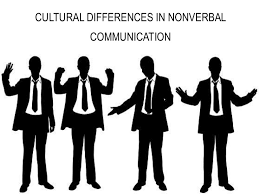How can we look at non verbal communication through a culturally relative lens?
- aidanbrotherton6
- Sep 23, 2020
- 3 min read
Updated: Sep 30, 2020
(Cultural Differences in Nonverbal Communication) Slideshare.net
Non-verbal communication differs greatly among various cultures. Several key differences are gestures, facial expressions, and how they look at time. One example of this is how in the United States making eye contact can be a show of respect, in other cultures however it may be viewed as disrespectful. It is important to be culturally relative and to not think of yours as the “correct culture”. All cultures are unique and should be respected equally. The opposite is called ethnocentrism. It is important especially in a classroom or in a workplace to know how to be respectful to everyone so that no one gets offended.
(Cultivating Diversity in the Classroom) Blog.cph.org
One organization that is trying to teach the masses about non-verbal communication through different cultural lenses is the Wisconsin Center for Education Research. The (WCER) runs a project called ALTELLA which researches instructional practices, accessibility features, and accommodations for English learners with disabilities in order to develop an approach that can most effectively evaluate their English language proficiency. They want to share this approach with other teachers so that they can incoporate it into their classrooms and better communicate with their students. This project was done due to the lack of intercultural competence considerations for those with cognitive disabilities. In the project brief by Laurene L. Christensen and Vitaliy V. Shyyan it says, “there may be nonverbal communication patterns that exist in only the student’s home or school culture. In all cases, it is important to know what these individual nonverbal communication behaviors are in order to effectively communicate with the student” (https://altella.wceruw.org/). This project looks at how different cultures may differ in tone, touch and personal distance, eye contact, turn-taking, facial expressions and Gestures. The ALTELLA project recognizes that people communicate differently non-verbally throughout different cultures and wants to get teachers to have cultural relativism and to be able to find the way to best communicate with student with cognitive disabilities.
(Cultural Strategies for Emerging Media)
Another organization that is teaching people how to look at non-verbal communication through different cultural lenses is the Public Broadcasting Service or PBS. One article by Marcelle E. DuPraw and Marya Axner called Working on Common Cross-cultural Communication Challenges talks about the different things that can be difficult about communicating through different cultures. The article says that there are 6 fundamental patterns to cultural difference: Different communication styles, different attitudes toward conflict, different approaches to completing tasks, different decision-making styles, different attitudes toward disclosure, and different approaches to knowing. The article says, “don't assume that there is one right way (yours!) to communicate. Keep questioning your assumptions about the "right way" to communicate. For example, think about your body language; postures that indicate receptivity in one culture might indicate aggressiveness in another.” (https://www.pbs.org/ampu/crosscult.html) Being culturally relative and aware of cultural differences around you can help prevent misunderstandings and conflicts. PBS publishes this article to help people do exactly this and it goes on to mention several tips for doing so and preventing potential conflicts.
The most beneficial thing an organization can do to get people to look at non-verbal communication through a culturally relative lens is spread to spread awareness about it. This will allow workplaces, schools, and other culturally diverse places to implement these practices and in turn, be able to communicate more effectively and prevent ethnocentrism and xenophobia.




Comments